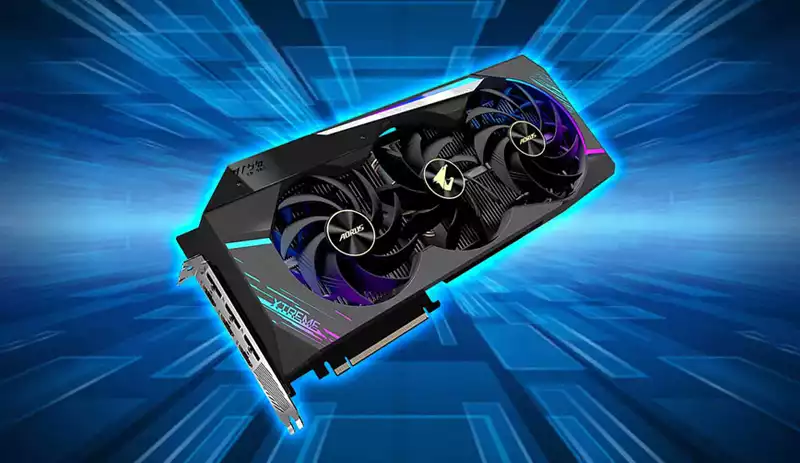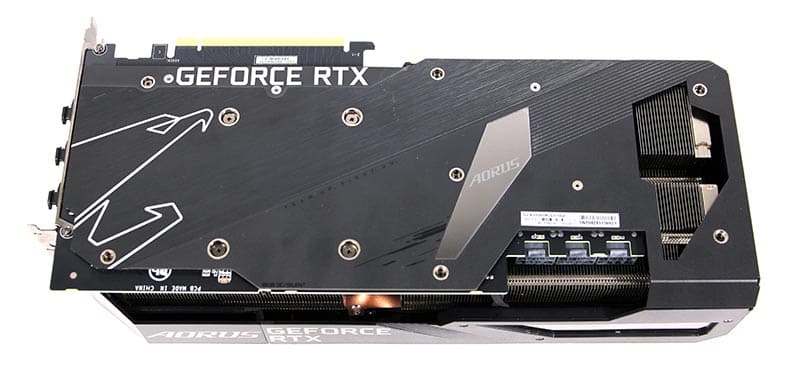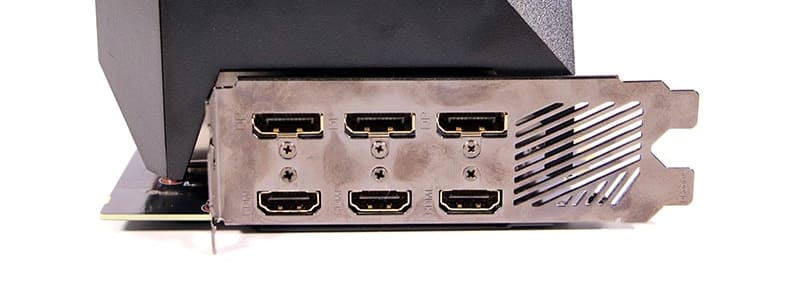You can also be interested in these:
- NVIDIA GeForce GT 720 review
- NVIDIA GeForce GTX 1050 Ti Max-Q review
- NVIDIA Quadro FX 3800 review
- Nvidia GeForce RTX 4090 full review
Are you ready to review the most powerful RTX 3080? This is no other than the Aorus RTX 3080 Extreme 10G, most commonly known as the Aorus 3080. This model features, hands down, the highest performance cooling heatsink we have ever tested. An impressive graphics card in both performance and design, with super cool LCD side screen displaying live data about the card, on its 2.75 inches thick and 12.6 inches long measurements.

The Aorus 3080 comes with a custom triple fin fan system which allows us to have an overclock of 1905 MHz, translating into a very stable 2040 MHz clock in games. Put simply, there is no factory setting more extreme than this, although it is not for everyone or for all chassis. Keep reading this article to find out more. Here is a link with more information about the Nvidia RTX 3080.
AORUS RTX 3080 Extreme 10G specifications
Here are a few important highlights about the Aorus 3080 unit capabilities:
| Architecture | Ampere, 8nm Samsung |
| Chipset | GA102 |
| Processing Speed | Base frequency: 1440 MHz Boost frequency: 1905 MHz |
| Core Count | 8704 CUDA Core 272 Tensor Core (3rd Gen) 68 RT Core (2nd Gen) |
| Memory | 10 GB GDDR6X |
| Memory Speed | 9500 MHz Clock 19 Gbps Transfer speed |
| Memory Bus | 320 bits (760 GB/s) |
| Cooling | Triple cooling fan |
| DirectX | DirectX 12 Ultimate Vulkan 1.2, RT API OpenGL 4.6 |
| Connectivity | 3x HDMI 2.1 3x DisplayPort 1.4a |
| Measurements | 12.5 x 5.5 x 2.75 inches |
| TGP | 450 W |
Gigabyte has done its best assembly job on this graphics card, on which has been implemented a VRM of 20 power phases + 3 secondary. As usual, it is divided into two different zones space distribution reasons. The BIOS of this GPU has already undergone two updates, and one of them has served to increase the TGP of the set to 450W when we use the OC mode.

This model starts from a base frequency of 1440 MHz, and will reach a boost frequency of 1905 MHz. In principle, the OC mode does not include a clock increase in the configuration, but in practice it goes from marking a stable 1980 MHz to 2055 MHz, almost hitting the limits for this graphic card. In the product manual’s overclocking section it says that the power limit cannot be raised more than it already comes from the factory, although it is really not necessary.
To learn more about graphic cards specs visit our GPU 101 article, with everything you need to know about these components.
In terms of chipset and memory specifications, we have exactly the same characteristics as other models as is obvious. The GA102 chipset has a total of 68 SMs, which inside we find 8704 CUDA Cores, 272 Tensor Cores and 68 RT Cores. The capacity therefore rises to 272 TMUs and 96 ROPs, however, we expect to see improved performance figures for an RTX 3080 with its 450W custom TGP, 120W more than the base model would offer.
Finally reviewing the memory configuration on the Aorus 3080, we have a capacity of 10 GB with Micron chips of the GDDR6X type. These raise the effective frequency to 9500 MHz, thus reaching a transfer of 19 Gbps, 5 Gbps more than the previous generation. The bus width rises to 320 bits thanks to 10 32-bit chips, and the bandwidth to 760 GB / s.
The Aorus 3080 design
As its name already suggests, the design of the Aorus RTX 3080 Extreme 10G can be summarized in the word “extreme”. The distinctive style and constitution you can find in the Gigabyte gaming division products is unique, and we could dare to say it is one of the best visually appealing cards on the market, although maybe this feature doesn’t help a lot when it comes to the price.
The case in the Aorus 3080 is made out of an excellent quality rigid plastic, with a thickness somewhat greater than a millimeter, which is considerably rugged. Improving the finishes, mostly all of the surfaces around the fans have a brushed-style metal plate and up to 3 RGB lighting zones. Two of them remain in the corners and part of the edge of the fans, having a ribbon running through part of the upper area with another metal plate.
Seen from a side we can realize how thick the Aorus RTX 3080 Extreme 10G really is, with 2.75 inches and no less than 5.5 inches wide. The clean and modern style is maintained on the card profiles, with the front completely covered and the visible side area. There are enough lighting regions in the card and a conspicuous opening for the power connections.
The most important thing about the Aorus 3080 design is its LCD screen that we can manage from the RGB Fusion 2.0 software. In it we can load predefined animations, text and personalized GIFs, images and of course real-time telemetry of the GPU such as temperature or frequency.
Now we focus our attention on the fans, with a total of three units, the two outer ones have a diameter of 115mm while the central one has only 100mm. Thereby, the length a bit compressed and more advantage can be taken for components distribution. Gigabyte calls this design “Wind Claw”, and uses an aggressive flap-like style with a cover that improves air flow. As with all Gigabyte heatsinks, the fans have an alternate spinning system and a semi-passive profile to remain off when the GPU is idle.
Moving on to the backplate area we have a large aluminum plate that also has a lighting area. It remains fully closed except for the far left where it opens slightly to generate air flow. This creates a steeper temperature gradient at the end for greater heat dispersion.
Discreetly on the edge, a Dual BIOS switch has been installed in the Aorus 3080 model, with silent mode and classic OC. In addition to changing the fan profile, it seems that the OC mode increases the clock frequency of the GPU and wit it, the TGP to 450W. In the CPU-Z sensor we went from 1980 MHz to a stable 2040 MHz, which is a huge improvement.
Aorus 3080 ports and connectivity

We have many ports and connection options in the Aorus RTX 3080 Extreme 10G for the fan and the lighting. As for video connections, there are 3 HDMI 2.1ports and 3 DisplayPort 1.4a. However, even seeing 6 display outputs, the maximum capacity will be four video sources at a maximum resolution of 8K. On the Aorus 3080 both HDMI 2.1 and DisplayPorts will be able to reach 8K @ 60 FPS, although the new version of HDMI will support up to 120 FPS and 144 Hz in uncompressed 4K.

The fan connections and the lighting part will be fairly accessible from the outside. We have a PCIe 4.0 interface compatible with Nvidia’s new Resizable Bar feature.
The power input is composed of three 8-pin EPS type ports: it is the maximum possible configuration that we have seen in current times. This will require our source to have two independent PCIe outputs with a total of 4 connectors. It would be advisable to have a power supply with a power of at least 700W or higher.
Heatsink and cooling
The heatsink of the AORUS RTX 3080 Extreme 10G is the best we have seen in a graphics card, and has the advantage of being the thickest available compared to all other manufacturer’s models. It is composed of two blocks of approximately 5.5 cm high made of aluminum with diagonal fins. At their end, the fins are slightly twisted in order to channel the air flow in such a way it increases the contact surface.
The union of both blocks is made using 7 thick bare copper heatpipes with a steam chamber inside. 5 of them are distributed in the second block, while 4 return on itself to enter the main block and improve the thermal efficiency. All of them remain soldered directly to the copper cold plate that is responsible for cooling the chipset and the VRAM memory chips.
Two aluminum cold plates integrated on the heatsinks are responsible for the two regions occupied by the card’s VRM, always making contact with chokes and Mosfets through silicone thermal pads. The backplate area will also act as a heatsink for areas where the memory and VRM chips remain soldered.
Final remarks of this Aorus RTX 3080 Extreme 10G review
The Aorus 3080 will not disappoint you at all. It has become the most powerful RTX 3080 version available. It is true that in other models we can manually raise the TGP and the frequencies by overclocking, but the AORUS RTX 3080 Extreme 10G already includes it out-of-the-box, without any tweaks.
This card has also a high-quality build, with a powerful 22-phase VRM that outperforms its rivals and a colossal heatsink improves the cooling in a considerable way. For practical purposes, temperatures are around the figures of other cards with 60oC in OC mode and 67oC in Silent mode, with a good set of fans. To this is added a modern, minimalist and at the same time very gamer oriented design with multiple lighting zones and even a customizable LCD screen. The only downside on this department is the size, therefore very few computer cases will support vertical mounting with this card.
The important thing comes in the performance section, beating the best models by about 3 to 5 FPS in most games, which is huge considering that the chipset and memories are the same. The optimization that the manufacturer has done giving it 450W of TGP and reaching home frequencies of 2055 MHz will be the best asset for the most demanding gamers. Of course, on a negative note, the price is also a little steeped as it sits around the $1800 USD, but it is the best of the best.
More stories like this
- NVIDIA GeForce GT 720 review
- NVIDIA GeForce GTX 1050 Ti Max-Q review
- NVIDIA Quadro FX 3800 review
- Nvidia GeForce RTX 4090 full review
- AMD Radeon R9 M280X GPU review: Powerful and affordable
- Nvidia Geforce GTX 560 Full Review